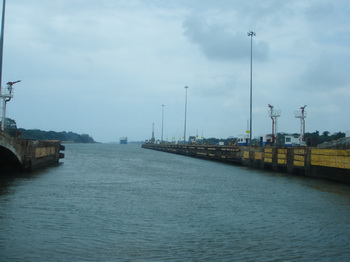
Waiting to transit
the Panama Canal
March 2010
Part Four
| |
| HOME |
| About Tenaya |
| About Us |
| Latest Update |
| Logs from Current Year |
| Logs from Previous Years |
| Katie's View |
| Route Map |
| Links |
| Contact Us |
![]()
March 23, 2010
The wind was light and on the nose for the first six hours as we motored northwest after leaving the San Blas Islands at 6:00 pm on March 17. Once we changed direction to the southwest the jib came out and we sailed nicely in 10 kt. wind with slight seas.
One ship an hour passed near us from the time we left until about 0230 when Mike decided to wake up Jim because there were so many ships in sight, on radar and on AIS. They stood watch dodging these behemouths until we were safely inside the breakwater about 8:30 am.
The overnight trip was 87 miles from Isla Porvenir in the San Blas Islands to Shelter Bay Marina at the entrance to the Panama Canal, and took 15 1/2 hours to complete.

AIS targets (big ships) near the breakwater of the Panama Canal
There are strict procedures to follow and a series chores to complete before yachts are given a time to transit the Panama Canal. The canal fee must be paid, the boat must be measured by an official, line handlers must be arranged, fenders (tires) must be ordered and four long lines must be on board. An agent is recommended to help make it all run smoothly. John from Mahina Tiare advised we contact Tina McBride and are happy with the service she has provided thus far.
We have been in the marina five days now and have met several other yachties trying to get through. Some have nightmarish stories while most say they have experienced delays. Each step is going smoothly and timely for us so it seems the decision to hire a good agent was wise.

Shelter Bay Marina is not a bad place to be waiting. Bordered by the entrance to the canal on one side and jungle on the other, it is a peaceful setting.
The marina provides a bus twice daily to take yachties into the nearest town of Colon. There we can get groceries, SIM cards and various other things at the "safe" mall. Walking the streets of Colon is not recommended so we will get our city fix once we are in Panama City on the Pacific side of the canal.
A highlight of the bus trip to Colon is crossing the first Gatun Locks. It is the only road on the Atlantic side of Panama connecting North and South America.

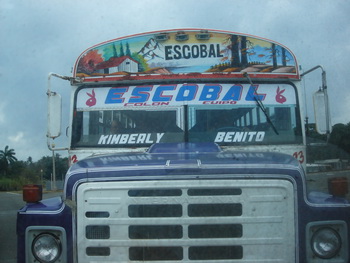
Elaborately painted old U. S. school busses careen wildly, honk furiously and belch black smoke in Colon
Mike came back to the boat after a short walk around the first day very excited. "Come with me, I've got something to show you" he exclaimed. Jim and I followed him into the jungle on a paved road in what used to be a neighborhood when Fort Sherman was active and the Americans were here. Now only foundations, fire hydrants and the odd building remain. We turned down one street and stopped under the green canopy of palm and fichus trees and looked up. Slowly we started to notice them. Monkeys. Lots of them. Swinging among the trees.
.
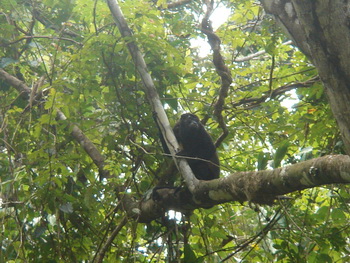
Howler monkey
Those particular monkeys were white-headed capuchin monkeys but howler and spider monkeys also populate the area. Earning their name, the howlers make a loud, eerie, haunting howling sound that would be frightening if one were alone in the jungle after sunset.
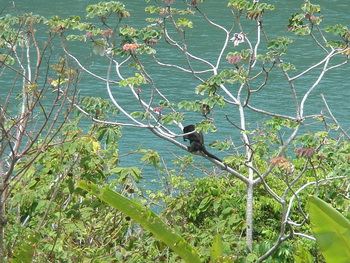
Another howler monkey
Long trails of leaf cutter ants are everywhere! Relatives of the honeybee, a queen lays all the eggs to keep the colony supplied with workers. Different workers do different jobs. Soldier workers' jaws are strong enough to cut through leather and vibrate at 1000 times a second to cut leaves. Harvester workers transport the leaves that can weigh up to 20 times their body weight while gardener workers live underground and process the leaves. The ants do not eat the leaves but cultivate the compost and eat the fungus. There can be 3 to 8 million ants in a single colony.

Harvester leaf cutter ants can carry up to 20 times their body weight
Panama is a birders paradise. People come from all over the world to see the 400 different species of birds. None of us are birders so we cannot identify any of the gorgeous individuals we have seen during our visit. We have seen several types of hawks and a few types of parrots, one with red under its wings, another all green. Several species have bright yellow markings either on their bodies or their lower tail feathers and many elusive birds have beautiful songs. One species, the chestnut-headed oropendola, nests in the same tree each year. The nests droop from the ends of the limbs and look like the handbags the local indians make called chacaras so the bird is also known as a chacarero. Fortunately there was a sign explaining this to us. We hope to see a toucan but are not holding our breaths.
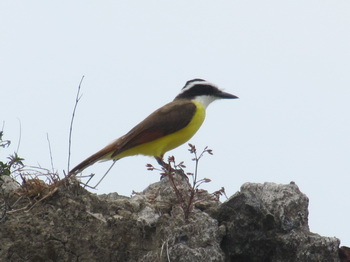
Very common, pretty bird. I have no idea what it is.
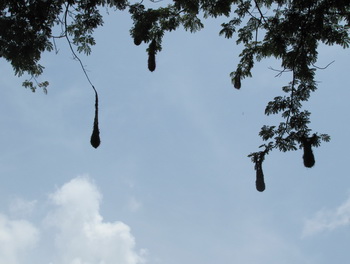
Nests of the chestnut-headed oropendola, a dark bird with bright yellow tail feathers that sings a lovely song.
.
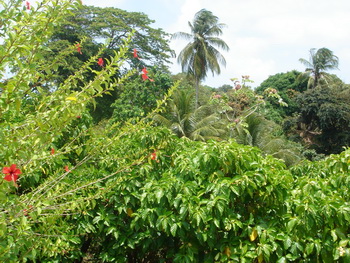
The three of us took a walk to Fort San Lorenzo about six miles from the marina. Although the temperature is hot and humid we were often in the shade of the forest canopy as we walked along a perfectly paved road in the national park.
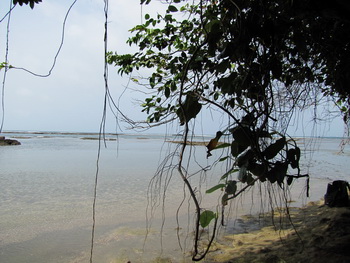
Tortuigilla
A sign pointing down a road labeled Tortugilla caught our attention. We thought maybe it had to do with turtles so went to have a look. After a mile we came to a small cove with a sandy beach. No turtles in sight but a local guy digging for crabs. Once caught, he pulled the legs off and popped them in his pocket to use later as bait. A bit cruel, we thought.
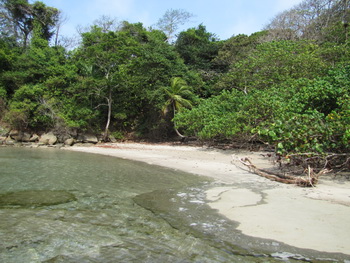
Nice sandy beach and cove at Tortugilla


Mike bouldering
Fort San Lorenzo was originally built in 1597 at the mouth of the Chagres River to protect the Caribbean coast from pirates. In 1671 Henry Morgan captured it and used it as a base to attack Panama, then Columbia. When he was finished he blew it up. Six years later the Spanish rebuilt it fortifying it with more cannons. In 1740 English Admiral Edward Vernon bombarded, captured and demolished it. Again the Spanish rebuilt it. In 1821 Columbia declared its independence from Spain and it was from here the Spanish troops left the region. During WWII the U. S. Army installed artillery to help defend the coast and the canal.
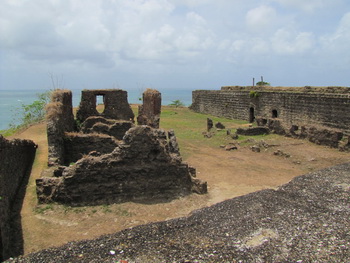
Remains of Fort San Lorenzo

The Chagres is the world's most valuable river. It has seen more gold than all the other rivers of the world combined. Its valley contained so much gold at the beginning of its recorded history that the Spanish called Panama "Castilla del Oro".
The pillaged wealth of the Peruvian Incas was moved down the Chagres. This was more than the total sum of gold in all of commercial Europe. Later Americans brought nearly all the gold that was mined from the California Gold Rush of 1849 across the isthmus and down the Chagres.
Today the Chagres carries the bulk of the worlds trade between the Pacific and Atlantic oceans. The Panama Canal can operate because of it. It fills the lakes, fills the locks, generates the electrical power and furnishes drinking water. Each of the 14,000 vessels that pass through the Panama Canal per year require 52 million gallons of fresh water from the Chagres River for passage.
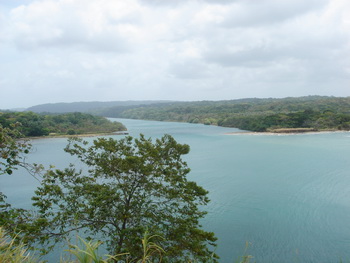
Chagres River
On our walk back to the marina we came across a car stopped in the middle of the road with its hazard lights flashing. A man hunched by the side of the road taking pictures of something. A sloth! It had been crossing the road he protected it from speeding cars while the creature slowly pulled itself along. Because of their slow metabolisms sloths appear incredibly lethargic and it took quite some time for it to pull with its long forelegs and push with its short hindlegs until it reached a tree where it deliberately and more confidently climbed to safety.
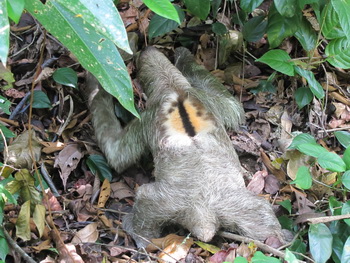
Sloths have difficulty moving on the ground
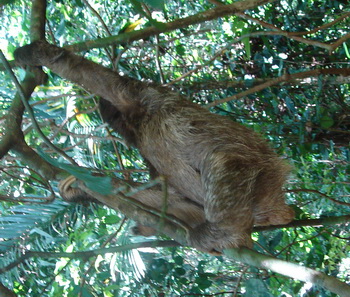
They are slow but agile in the trees
A little further down the road Jim heard a noise and went to investigate. It was an anteater tearing apart a dead limb to reveal tasty termites, one of his main sources of nutrition. Adults can eat up to 30,000 ants and termites a day. Unlike giant anteaters that grow to 6 feet, this little guy was less than 3 feet from the tip of his long, narrow snout to the end of his prehensile tail.

Anteater dining on termites
Some people have seen boa constrictors and black panthers (dark jaguars) in the nearby jungle. It is fine with us to miss sightings of those creatures.
We are set to transit the canal on Saturday and Sunday and will post our estimated time to pass the Miraflores Locks on the tenayatravels page on Facebook. A webcam allows real-time views of the ships in the locks. Thursday and Friday we will go through as line handlers for another yacht to gain experience for our own transit.
Go to March 2010 Part Five - Transiting the Panama Canal
.